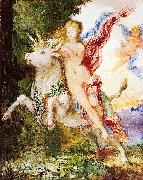Wholesale Oil Painting No Minimum |
|||||||||||
|
|
|||||||||||

|
|||||||||||
|
|
|
||||||||
Gustave MoreauFrench 1826-1898 Moreau's main focus was the illustration of biblical and mythological figures. As a painter of literary ideas rather than visual images, he appealed to the imaginations of some Symbolist writers and artists, who saw him as a precursor to their movement. His father, Louis Jean Marie Moreau, was an architect, who recognized his talent. His mother was Adele Pauline des Moutiers. Moreau studied under François-Édouard Picot and became a friend of Th??odore Chass??riau, whose work strongly influenced his own. Moreau carried on a deeply personal 25-year relationship, possibly romantic, with Adelaide-Alexandrine Dureux, a woman whom he drew several times.[1] His first painting was a Piet?? which is now located in the cathedral at Angoul??me. He showed A Scene from the Song of Songs and The Death of Darius in the Salon of 1853. In 1853 he contributed Athenians with the Minotaur and Moses Putting Off his Sandals within Sight of the Promised Land to the Great Exhibition. Oedipus and the Sphinx, one of his first symbolist paintings, was exhibited at the Salon of 1864. Over his lifetime, he produced over 8,000 paintings, watercolors and drawings, many of which are on display in Paris' Mus??e national Gustave Moreau at 14, rue de la Rochefoucauld (IXe arrondissement). The museum is in his former workshop, and was opened to the public in 1903. Andr?? Breton famously used to "haunt" the museum and regarded Moreau as a precursor to Surrealism. He had become a professor at Paris' École des Beaux-Arts in 1891 and counted among his many students the fauvist painters, Henri Matisse and Georges Rouault. Moreau is buried in Paris' Cimeti??re de Montmartre. In Alan Moore's graphic novel, The League of Extraordinary Gentlemen, it is implied that he was a nephew of Doctor Moreau, and he based a few of his paintings on the Doctor's creations. |
||||||||
|
|
||||||||
Europa and the Bull
Europa and the Bull Painting ID:: 59957 |
Europa and the Bull (1869).
Europa and the Bull (1869). |
|||||||
|
|
||||||||
|
Fra Bartolommeo Italian c1474-c1517 Fra Bartolommeo Location Italian painter and draughtsman. Vasari and later historians agree that Fra Bartolommeo was an essential force in the formation and growth of the High Renaissance. He was the first painter in Florence to understand Leonardo da Vincis painterly and compositional procedures. Later he created a synthesis between Leonardos tonal painting and Venetian luminosity of colour. Equally important were his inventions for depicting divinity as a supernatural force, and his type of sacra conversazione in which the saints are made to witness and react to a biblical event occurring before their eyes, rather than standing in devout contemplation, as was conventional before. His drawings, too, are exceptional both for their abundance and for their level of inventiveness. Many artists came under his influence: Albertinelli, Raphael, Andrea del Sarto, Titian, Correggio, Beccafumi, Pontormo and Rosso Fiorentino. Europa and the Bull 1470-90 Bronze, height: 22 cm Museo Nazionale del Bargello, Florence Bellano, a sculptor from Padua was an assistant to Donatello when the old master worked on the pulpits of San Lorenzo in Florence. The statuette depicting Europa and the Bull was executed in Padua. The small bronze statuette reflects a naturalistic style heavily tempered in spirit by Donatello's classicism. Author: BELLANO, Bartolommeo Title: Europa and the Bull , 1451-1500 , Italian Form: sculpture , mythological |
||||||||
|
|
||||||||
|
Prev Next
|
||||||||
|
|
||||||||
|
Related Paintings to Fra Bartolommeo :. |
||||||||
|
|
||||||||
|
CONTACT US |

